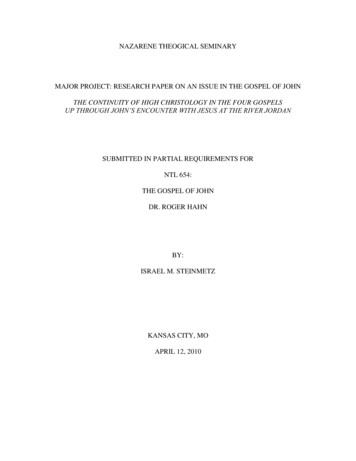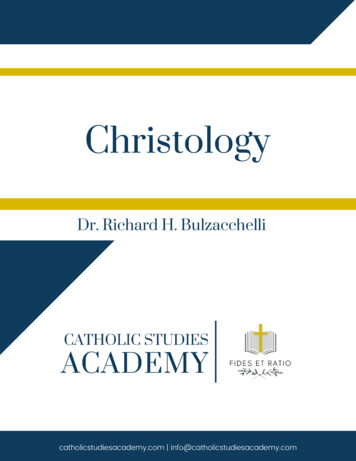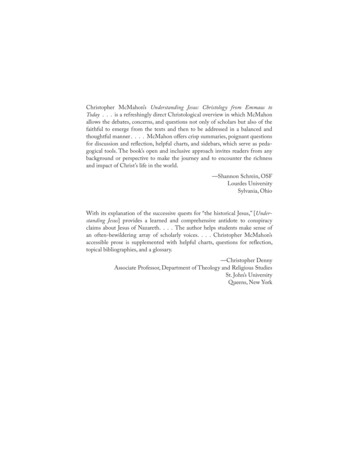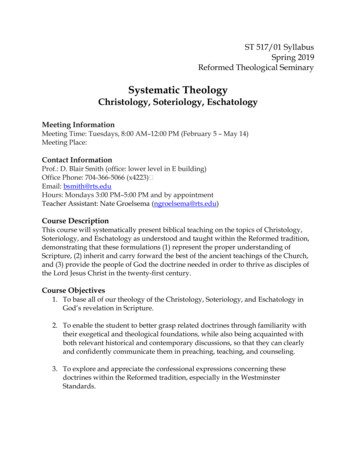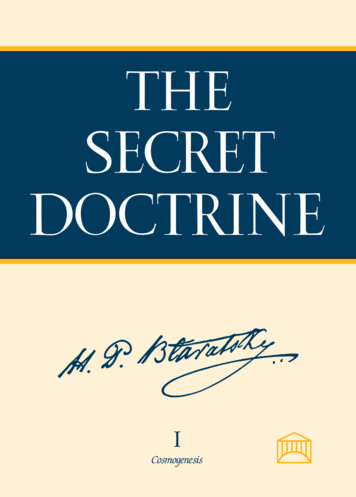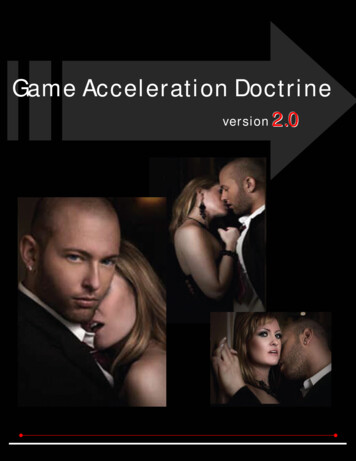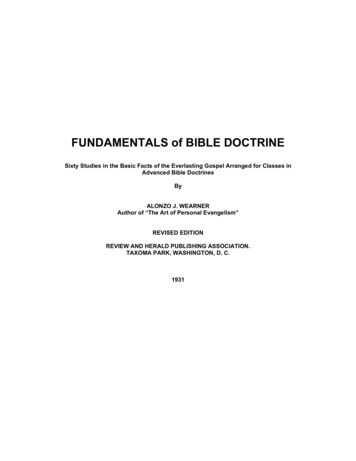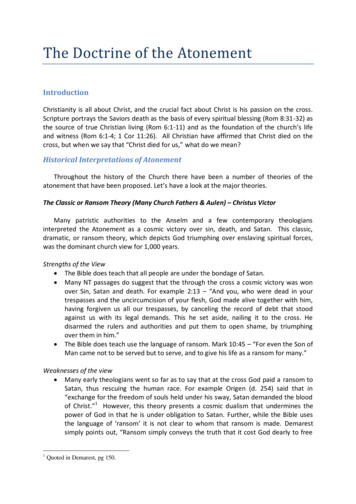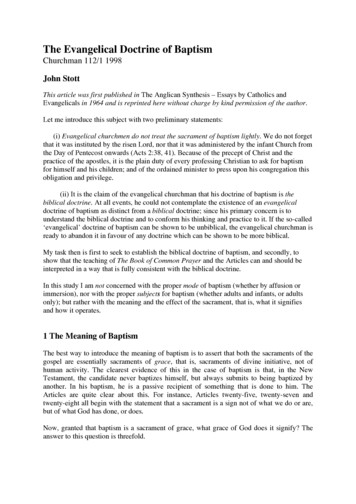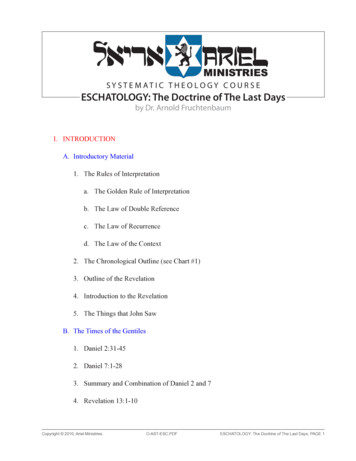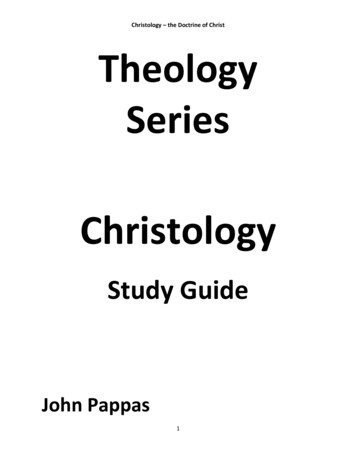
Transcription
Christology – the Doctrine of ChristTheologySeriesChristologyStudy GuideJohn Pappas1
Christology – the Doctrine of ChristCopyrightJohn Pappas, Th.M, Th.D20152
Christology – the Doctrine of ChristTable of ContentsWho is God? . 4Christological Heresies . 5Eternality & Pre-existence of Christ . 6Pre-existence of Christ . 7OT Typology of Christ . 8OT Typology of Christ . 9OT Prophecy of Christ . 10OT Prophecy of Christ - The Messianic Line . 12The Incarnation of Christ . 13The Incarnation of Christ – His Humanity . 14The Incarnation – The Divine Side . 16The Hypostatic Union. 18Kenosis . 19The Temptation of Jesus Christ . 20The Miracles of Jesus Christ . 21The Transfiguration of Jesus Christ . 22The death of Jesus. 23The burial & resurrection of Jesus . 26Ascension of Christ. 27Bibliography . 283
Christology – the Doctrine of ChristWho is God?Session 1Who is God? God is ever-existing. He is the all-powerful creator. He is personal. God reveals Himself to us through various means:1. Through creation: Psalm 19:1-6; Romans 1:18-322. Through the conscience of man: Rom. 1:21; 2:14-153. The prophets: “the LORD said ”4. The Scriptures: 2 Tim. 3:16; 2 Peter 1:21; 1 Cor. 2:135. Miracles: Exod. 9:14; 1 Kg. 18:36-39; 2 Kg. 5:8-156. Holy Spirit: 1 Cor. 2:10-16; 1 John 4:1-6; John 14:26, 15:267. Jesus Christ:a. We see God in Christ (John 1:18; 12:45; 14:9)b. To know the Son is to know the Father (John 8:19; 14:7-9)c. The Logos “the Word” (John 1:1)d. The “Light of the World” (John 1:9; Heb. 1:3) The 8-fold witness of Jesus:1. Israel: Isa. 43:10-12; 44:82. Prophets: Acts 10:433. John the Baptist: John 1:7-8, 154. The Father: John 5:37-385. Jesus: “a self-witness” John 8:186. Holy Spirit: John 15:26; Acts 5:30-327. Jesus’ followers: Acts 5:30-32; Luke 1:28. Signs & wonders: John 2:1; 20:20-31; Heb. 2:44
Christology – the Doctrine of ChristChristological HeresiesSession 2I.The person of Jesus Christ attacked:1. By the Jewish leadership to preserve their control (John 11:48-50)2. By the world (John 7:7; 15:18-19)3. By some within the Churcha. Those who deny His deityb. Those who deny His humanity (1 John 4:1-3; 2 John 7)II.The Trinity1. God is One (Deut. 6:1-6; 4:35; Isa. 45:14; 46:9)2. God is plurala. His name – Elohimb. God uses plural personal pronouns when speaking of Himself (Gen. 1:26; 3:22; 11:7;Isa. 6:8)c. God uses plural verbs when speaking about Himself (Gen. 1:26; 11:7)III.Definition of Trinity:“There is one only and true God, but in the unity of the Godhead there are three coeternal andcoequal Persons, the same in substance but distinct in subsistence. “ - Warfield5
Christology – the Doctrine of ChristEternality & Pre-existence of ChristSession 3I.1.2.3.4.5.The pre-existence of Jesus Christ the Son (Col. 1:15-17; John 1:1-5, John 17:5; Heb.1:8)Old Testament: The NT refers to OT reference (Mic. 5:2; Isa. 9:6-7).God’s name YHWH “Yehovah” from the verb hayah “to be, exist.”Other references (John 8:56-58; Rev. 1:8; John 6:38)Where was Christ come from before His incarnation (John 6:38):Other refs of His heavenly origin: John 1:15, 18, 30; 3:13, 16; 6:33, 42, 50-51, 58, 62;7:29; 8:23, 42; 9:39; Eph. 1:3-5; 1 Pet. 1:18-206
Christology – the Doctrine of ChristPre-existence of ChristSession 4-5I.The pre-existence of Jesus Christ the Son Continued:1. Names and titles quoted in the New from the Old Testament:a. Yahweh (John 12:41 – Isa 6:1-5; Rev. 1:7 – Zech 12:1)b. Lord Adonai (Matt. 22:41-46 – Psalm 110:1; Heb. 1:1-12-Ps. 102-25-27)c. The Son of God (Matt. 3:17 - Ps. 2; Acts 13:33; Heb. 1:5; 5:5)d. Angel of the Lord (Gen. 16:7-13; 22:15-18; Ex. 3:2-4)2. Activities of the Angel of the Lord:a.righteous Judge (2 Sam. 24:14-17; 1 Chron. 21:11-30)b.He slays the 185,000 Assyrians (2Kings 19:35; Isa. 37:36)3. Other theophaniesa. As the man in Gen 18:1-33b. The man who wrestled Jacob in Gen. 32:24-25; Hos. 12:44. Christ appeared as a man.a. As the man in Gen 18:1-33b. the man who wrestled Jacob in Gen. 32:24-25; Hos. 12:4c. The Commander of the army of the Lord (Joshua 5:13-15)d. The man in the fiery furnace (Dan. 3:19-28)e. Some visions of God appear in the form of man (Ezek. 1:1-28; Dan. 10:1-21).7
Christology – the Doctrine of ChristOT Typology of ChristSession 6I. Typology in the Bible: Defn: A type is from the Greek ‘typos’ meaning “a pattern orimage.” A type is a divinely inspired OT foreshadowing of some spiritual reality in theNT.” A type found in the OT has a corresponding antitype found in the NT.II. Christ is the outstanding antitype in all typology.III. Christological types occur in 5 categories: (1) persons; (2) events; (3) things; (4)institutions; (5) ceremonies.1. Things/events/ceremonies:a. Sacrifices:i.Lamb of God (John 1:29, 36 – Gen. 22:9-18; the Lamb Acts 8:32; 1 Pet.1:19; Rev. 5:6-7:17; 12:11; 13:8-11; 14:1-10; 15:3; 17:14; 19:7-9; 21:922:3)ii.Christ in the Passover (Paschal) Lamb (1 Cor. 5:7; Matt. 26:2 – Exod. 12:513)iii.The Day of Atonement (Heb. 9:24-28, 10:1 - Lev. 16:6-10)8
Christology – the Doctrine of ChristOT Typology of ChristSession 7I.Persons:1. High Priest (Heb. 9:24-28, 10:1 - Lev. 16:6-10)i.The Day of Atonement2. Aaron/Melchedek (Heb. 5:5-6 – Gen. 14:18-20)3. Adam (Rom. 14-18; 1 Cor. 15:45-47 - Gen. 3)4. Kinsman-redemer (Heb. 2:14-15 – Lev. 25:48-49; Ruth 3:12-13)5. Tabernacle (eb. 8:5; 9:23-24)9
Christology – the Doctrine of ChristOT Prophecy of ChristSession 8I.Prophecy.Defn: Gr. προφητεῖαι (propheteia) from pro before or forth, and phemi to declare.Heb. ( נָ ִביא naba’) “to speak under divine influence.” It may be future-telling or simplydeclaring the word of God.1. God reveals prophecy (Isa. 46:9-10; 42:9)2. The prophet (seer)a. Three aspects: Preachers, Predictors, and Watchmen.b. Predictor:i.Near prophecy (1 Kgs. 17:1)ii.Far prophecy (Isa. 65:17)c. True and False Prophetsi. Test for true prophet (Deut. 18:21-22; 2 Pet. 1:19-21; Jer. 28:1-17)iii. Does it correspond to God’s word and consequences (Deut. 13:1-5)d. Prophecy will cease (1 Cor. 13:8-10)3. Jesus Christ the Prophet (Deut. 18:15, 18-20; John 16:14; Acts 3:21-23 )4. Jesus Christ as center of prophecy (1 Pet. 1:10-11; Rev. 19:10; Luke 24:27)10
Christology – the Doctrine of ChristSession 9I.The 1st prophecy (Gen. 3:11-15; Rom. 16:20)II.Who is Christ?a. The Messiah – Hebrew יח ַ ( ָמ ִש Meshiyach – Maw-see-akh) “anointed”. The anointedof God were priests (Lev. 4:3, 5, 16; 6:22) and kings (Saul in Sam. 24:6, 10; David in 2Sam. 19:21; 23:1; Zedekiah in Lam. 4:20).b. Christ – Greek Χριστός (Christos) “anointed” Christ is the Anointed of God.III.The prophecy of the Seed.a. The Tender Shoot (Isa. 53:1-6; John 12:37-38).b. The Branch (Isa. 11:1-6, Jer. 23:5; Zech 6:12-13)c. Fulfillment of the prophecy (Rev. 19:11-20:6)11
Christology – the Doctrine of ChristOT Prophecy of Christ - The Messianic LineSession 10I.a.b.a.b.c.d.The prophecy of His lineage.Virgin birth (Gen. 3:15 - Matt. 1:16; Isa. 7:13-15 – Matt. 1:23).Abraham (Gen. 12:12; Matt. 1:1-18)Isaac (Gen. 17:19-21)Jacob (Gen. 28:13-14; Num. 24:17; Rom. 9:10-14)Judah (Gen. 49:10)David (2 Sam. 7:12-16)II.Messiah’s birth?a. Place – Bethlehem “House of Bread” (Micah 5:2; Matt. 2:1-6)b. Nazareth (Matt. 2:23; John 1:45-46)c. Time of birth (Dan. 9:25:24-27)i.seventy weeks (lit. יםַש ְב ִ֜ ִעים ִ – ָש ֻב ִ֙ ִע seventy – sevens)th 7 day – Sabbath day, 7th year – Sabbath year 7 – sevens 7x7 49 years year of Jubilee 70 – sevens 70x7 490 yearsii.Time starts with the decree (Dan. 9:25) of Artaxerxes on Mar. 5, 444 BC (Neh. 2:1-8)iii.Duration 490 years divided: 7 “sevens“ 7x7 49 years 62 “sevens” 62x7 434 yearsiv.Messiah comes in 483 years (verse 25). Converting 360 day calendar to 365 calendar:483 years x 360 days 173,880 days173,880 days/365 476.38 years Most take this to be Christ’s Triumphal Entry into Jerusalem.12
Christology – the Doctrine of ChristThe Incarnation of ChristSession 11Incarnation (Latin “in flesh”): “the act whereby the eternal Son of God took to Himself anadditional nature, humanity, through the virgin birth. The result is that Christ remains foreverunblemished deity, which He has had from eternity past; but He also possesses true, sinlesshumanity in one Person forever (cf. John 1:14; Phil. 2:7-8; 1 Tim. 3:16).” (Paul Enns, MoodyHandbook of Theology)a. John 1:14b. Phil. 2:5-8c. 1 Tim. 3:1613
Christology – the Doctrine of ChristThe Incarnation of Christ – His HumanitySession 12I.The Humanity of Christa. The humanity of Christ is essential (1 John 4:1-3): What is it we are to believe? (John 1:14)a. He has all the characteristics of a human except sin and fallen nature (1 John 3:5):b. He had a true body of flesh and blood. Normal human birth (Gal. 4:4; Luke 2:5-7; Heb. 2:14) Normal human body and growth (Luke 2:41-52) He had a human soul and spirit (Matt. 26:37-39; Luke 23:46) He called Himself a man (John 8:30)c. Jesus was a Jewi.His genealogyii.His circumcision (Luke 2:21)iii.His name (Luke 2:21)Jesus Ἰησοῦς Iesous “ee-ay-sooce” from Hebrew Yehowshuwa’ “meaning “Jehovah is salvation”i.ii.iii.Born under the law (Gal. 4:4)His presentation (Luke 2:22)His prophetic presentation (Luke 2: 7-14; 2:25-35)1. By the angels (Luke 2: 7-14)2. By righteous man (Luke 2:25-35; Isa. 42:6; 49:6)14
Christology – the Doctrine of ChristThe IncarnationSession 13I.Messiah’s lifea. The Forerunner (Mark 1:1-4; Malachi 3:1; Matt. 11:10; Isa. 40:3; Matt. 3:1-7;John 1:23)i.ii.iii.iv.i.ii.iii.The message concerns repentance Gr. μετάνοια (meta-noia) “change themind” Mark 1:4 – “repentance for the remission of sins.”Baptism Gr. βαπτίζω (baptizo) “to dip, immerse, submerge, to wash,bathe”The kingdom of heaven is at hand. (Matt. 3:8-10)Jews thought they were acceptable to God on the basis of being Abraham’schildren (i.e. they were already members of the kingdom). (John 1:12-13)b. The baptism of Jesus (Matt. 3:11- 17)Water baptism is an external sign signifying relationship and identity (i.e.belief/repentance & new manner of life – cf. Acts 19:3-5 for believers baptism). Weare identified with Christ in His death, burial and resurrection.God’s pronouncement of the Son (Ps. 2:7-12’ Isa. 42:1; Matt. 3:16).The Holy Spirit’s work with Jesus (Isa. 42:1; 11:2; 48:16; 61:1)15
Christology – the Doctrine of ChristThe Incarnation – The Divine SideSession 14I.Jesus Christ’s deity (John 1:14)1. Look at Jesus’ deity from the perspective of His works.a. Characteristics of deity.i.Omnipresent (Matt. 28:20; John 14:23; Eph. 3:17; Col. 1:27): Defn: God iseverywhere present with His whole being (Not pantheism – God ineverything).ii.Omniscient (John 2:25; 4:18; 16:30; 1 Cor. 4:4). Defn: God knows all things,past, present, and future.iii.Omnipotent (Matt. 18:18; Mark 2:5-7; 1 Cor. 1:22-25). Defn: God is allpowerful and is able to do whatever He wills. He is (ַ ֵ֣אלַש ַּ֔די Gen 17:1)“God-Almighty”16
Christology – the Doctrine of ChristThe Incarnation – The Divine SideSession 15I.Jesus Christ’s deity (Phil. 2:5-9)1. Look at Jesus’ deity from the perspective of His works.a. Characteristics of deity.i.Immutable (Heb. 13:7-9; Mal. 3:6)ii.life (John 1:4; 14:6)b. His works – Christ performs the works of God.i.Creator (John 1:3; Col. 1:16)ii.Sustainer (Col. 1:17)iii.Forgiver of sins (Ex. 34:6-7; Mark 2:1-12; 1 John 1:9)iv.Miracle worker (Ps. 146:1-10; Mark 2:8-12; John 10:37-38; 20:30-31).v.He receives worship (Matt. 4:10; John 9:38)vi.Glory of God (1 Cor. 2:8)More attributes of God that Jesus possesses1. FaithfulnessHeb. 2:17; Rev. 3:142. GoodnessJohn 10:113. Grace/FullnessJohn 1:14-164. HolinessJohn 6:69; 1 Peter 2:225. LoveEph. 3:17-18; 1 John 4:86. Righteousness2 Tim 4:87. Self-ExistenceHeb. 7:168. TruthfulnessJohn 14:69. Wisdom1 Cor. 1:3010. SovereignJohn 3:3417
Christology – the Doctrine of ChristThe Hypostatic UnionSession 16I.Hypostatic union of the God-man (John 1:14; Matt. 26:64)“The two natures of Christ [divine and human] are inseparably united without mixture or loss ofseparate identity. He remains forever the God-man, full God and fully man, two distinct naturesin one Person forever.” (Paul Enns, Moody Handbook of Theology)Hypostatic Gr. hupo “under” histemi “to stand” nature or essence. The personal union ofthe human and divine natures in Christ. One person – two natures.1. Christ is one Person with two natures.a. One person: normal pronouns I, You, & He are used for Him.b. Both natures - divine & human attributes are described for Him.2. The union is not a temporary arrangement which ended with His death andresurrection – it continues forever.3. Purpose of the 2 natures.i.To reveal God to us (John 1:18; 14-7-11; 1 John 1:1-3)ii.To provide an example for our lives – to reveal man to man (1 Pet. 2:21; 1 John2:6)iii.To provide an effective sacrifice for sin (Heb. 10:1-10)iv.To destroy the works of the Devil (John 12:30-31; 16:8-11; Heb. 2:14-15; 1 John3:8)v.To fulfill the Davidic covenant (2 Sam. 7:16; Luke 1:31-33; Rom. 9:1-5 )vi.To be a sympathetic High Priest (Heb. 4:14-16)vii.To be a qualified Judge (John 5:26-27)viii.To be head over the Church (Eph. 1:22-23)This audio recording can be found at www.biblegreekvpod.com
Christology – the Doctrine of ChristKenosisSession 17I.What does He “emptied Himself” mean? (Phil. 2:5-9)Verse 7 - “emptied” Gr. κενόω (Kenoo) “emptied, made empty, made void.”“form of a servant” Gr. μορφη (morphe) “form, external appearance.”“likeness of men” Gr. ομοιωμα (homoioma) “likeness, a figure, image, resemblance,representation.”Verse 8 – “form of man” Gr. σχημα (schema) “the figure, action, manner of life.”i.The purpose (Phil. 2:10-13):II. Self-consciousness of Christ.III. The will of Christ of the two natures (John 5:25-30; 10:14-18; Heb. 5:5-10; 10:7)This audio recording can be found at www.biblegreekvpod.com
Christology – the Doctrine of ChristThe Temptation of Jesus ChristSession 18I.Temptation of Christ (Matt. 4:1-11)temptation: Gr. πειράζω peirazo {pi-rad'-zo} “to try whether a thing can be done, to test.”TemptationAppeal to physical appetite.Appeal to personal gain.Genesis 3You may eat of any tree(3:1)You will not die (3:4)Appeal to power or gloryYou will be like God (3:5)Matthew 4You may eat by changingstones to bread (4:3)You will not hurt your foot(4:6)You will have all the world’skingdoms (4:8-9)1. Jesus Christ and temptation :a. Temptation. God cannot be tempted in the way of evil, nor does He so tempt any man(James 1:12-15):b. Jesus Christ was tempted in the sphere of His humanity (Heb. 4:15-16).sympathize (Gr. συμπαθέω ‘sumpatheo’ compound of “together” “suffer”)i.The devil’s address to Jesus as the “Son of God” points to His divine side (Matt. 4:3). Turn stone to bread Response: Deut. 8:2-3ii.2nd temptation (Matt. 4:5-7). The devil uses Psalm 91 Jesus responds using Deut. 6:16iii.3rd temptation (Matt. 4:8-10) Satan offers the world Jesus uses His authority as the Son of God – the Word used His Word.This audio recording can be found at www.biblegreekvpod.com
Christology – the Doctrine of ChristThe Miracles of Jesus ChristSession 19I.Miracles of Jesus1. Demonstrates God is with a person’s work and message (John 3:1-2; Matt. 11:26)2. Incarnation is a miracle (Isa. 9:6)3. There is a purpose for Jesus’ miracles – to reveal His glory that you mightbelieve the message (John 2:11; 14:29) and to bring people to faith (John 20:2631)4. Character of Jesus’ miracles:a. Messianic in scope (Matt. 12:26-28)b. Different than the apostles (Matt. 10:1- 10; Luke 11:20;)c. His Father’s work (John 10:37-38)5. To demonstrate God is LORD over all creation:a. Lord over the natural world:i.Lord over time – water to wine (John 2:1-11)ii.Lord over the natural elements – stilling the storm (Matt. 8:23-27; cf.Ps. 107:29)iii.Lord over the natural laws – walking on the water (Matt. 14:24-25; cf.Isa. 30:41)iv.Lord over the animal world – catch of fish (Matt. 14:24-25; cf. Isa. 11:68)v.Lord over the human body – healing the blind (Matt. 9:27-30; cf., John9:1-7; Ps. 146:8)vi.Lord over death – raising the dead (Matt. 9:18-26; John 11:1-44; cf. Ps.49:15; Isa. 65:20)b. Lord over the spiritual world:i.Lord over demonic world – casting out unclean spirits (Mark 1:23-26;cf., 5:1-20; 7:24-30; 9:14-29 )This audio recording can be found at www.biblegreekvpod.com
Christology – the Doctrine of ChristThe Transfiguration of Jesus ChristSession 20I.The transfiguration of Jesus (Matt. 16:27-17:1-11; Mark 9:1-8; Luke 9:2636; 2 Pet. 1:16-21)Summary1. The transfiguration portrays the power and coming of Christ in His kingdom.17:2 transformed μετεμορφώθη ‘metamorphoo’ “to change into another form,transfigure, transform, change” ; white λευκὰ ‘leuka’ “brilliant from whiteness”This audio recording can be found at www.biblegreekvpod.com
Christology – the Doctrine of ChristThe death of JesusSession 21I.The death of Jesus (Ps. 22:11-18; Isa. 53:12)1. He died an unjust death (Ps. 22:12-18; 1 Pet. 3:18; cf. Zech. 12:10; 13:6-7))2. He predicted His death (Mark. 8:31; Luke 9:22)3. His death was substitutionary (Isa. 53:5; Gen. 3:15; 1 Pet. 2:21-24; 2 Cor. 5:21;Rom. 6:23; 5:8-10; Heb. 2:17-18; 1 John 2:2; 4:9-10 )a. Vicarious – Latin for “substitution,” “one in the place of another.”b. He offered up (1 Peter 2:24 - ἀναφέρω anaphero {an-af-er'-o} , to bear, carry up,religious offered up)c. 2 Cor. 5:21: “For us” Gr. ὑπέρ huper {hoop-er'} “in our behalf” “in our place”4. His death was a propitiation (Heb. 2:17-18; 1 John 2:2; 1 John 4:10)This audio recording can be found at www.biblegreekvpod.com
Christology – the Doctrine of ChristThe death of Jesus - Part 2Session 221. Redemption ( 1 Cor. 6:20; 7:22; )a. You were bought with a price (1 Cor. 6:19-20)bought: ἀγοράζω agorazo {ag-or-ad'-zo} “to be in the market place, to do businessthere, buy or sell. Specifically used of buying and selling in ancient public slave market.b. Christ’s slave (1 Cor. 7:21-24)c. Redeemed from the curse of the law (Gal. 3:13-14; 4:4-7)i.Kinsman-redeemer.d. Redemption price (Rev. 5:6-10; 1 Pet. 17-19; 1 John 1:7-9)i.Extent of redemption (Rev. 14:3-4)e. Forgiveness of sins (Eph. 1:7)2. Imputation (Lev. 7:18; Lev. 17:4)i.Righteousness imputed to man (Lev. 7:15-18)imputed Hebrew ָחשב chashab “to account, reckon, charge to the account.”ii.Sin imputed to man (Lev. 17:3-4)iii.Three great imputations of Scripture:a. Imputation of Adam’s sin to the human race (Rom. 5:10-13)b. The imputation of the sin of mankind to Christ (1 Pet. 2:24)c. Imputation of righteousness of Christ to believers (Rom. 4:20-25)This audio recording can be found at www.biblegreekvpod.com
Christology – the Doctrine of ChristThe death of Jesus - Part 3Session 233. Reconciliationi.Believers are reconciled to God (Rom. 5:1-11; 2 Cor. 5:18-21)Reconciliation καταλλάσσω katallasso {kat-al-las'-so} : to change, return to favor.Passive Verb. “we have been reconciled”ii.The world is being reconciled to God (2 Cor. 5:17-21; cf., Eph. 2:16; )iii.Individual reconciliation (Col. 1:21-22; 1 Cor. 1:30)iv.Other events (Matt. 27:50-54; John 3:16-19)This audio recording can be found at www.biblegreekvpod.com
Christology – the Doctrine of ChristThe burial & resurrection of JesusSession 24I.Death, burial and resurrection are essential to the Gospel (of Christ)message (1 Cor. 15:1-6)1. Buriala. Prophesied in the OTi.Buried in a rich man’s tomb (Isa. 53:9; Matt. 27:57-60)i.II.b. Theological significanceBaptism – dying with Christ (Rom. 6:1-6; Col. 2:11-14)Resurrectiona. Prophesy concerning His resurrection (Ps. 16:10)b. The power used to raise Christ.i.The power of God the Father (Act. 2:23-24; Eph. 1:19-20; cf., Col.2:12)ii.The power of the Holy Spirit (Rom. 8:11-12; 1 Pet. 3:18)iii.Christ’s own power (John 10:18; 11:25-26)c. Theological significancei.Declares His deity (Rom. 1:1-4; cf., Matt. 12:38-40)ii.Justifies believers (Rom. 4:23-25)iii.Forgives believers (1 Cor. 15:17)iv.Saves believers (Rom. 10:9; cf., 1 Pet. 3:21)v.Guarantees believers resurrection (1 Cor. 15:20-21,23; Phil. 3:1011)vi.Gives believers a living hope (1 Cor. 15:18-19; 1 Pet. 1:3)This audio recording can be found at www.biblegreekvpod.com
Christology – the Doctrine of ChristAscension of ChristSession 25The ascension marked the end of Christ’s earthly ministry (Mark 16:19;Luke 24:51, Acts 1:6-11)I.1. What did His ascension mean?a. Ascension ended His period of humiliation and veiled glory as He is now exalted(John 17:5; Acts 9:3-5;cf., Heb. 2:9)b. It marked the first entrance of resurrected humanity into heaven and a new workas intercessor (Heb. 4:14-16)c. It marked a new work as intercessor (Heb. 6:20-21)d. The ascension made the descent of the Holy Spirit possible (John 16:7-11)2. Immediate results of the Resurrection and ascension of Christi.A change in the disciples to boldness.3. Present Ministry of Christa.b.c.d.e.f.g.The continuance of the office of Priest (Heb 6:20-21)Christ is building His Church (Eph. 1:20-23)He is preparing a place for us (John 14:1-3)Christ is producing fruit in the lives of believers (John 15:1-7)Angels, authorities and powers are subject to him (1 Pet. 3:22)He fills all (Eph. 4:10)Believers’ who die go directly into the presence of Christ (2 Cor. 5:6-8; cf.,Phil. 1:23)This audio recording can be found at www.biblegreekvpod.com
Christology – the Doctrine of ChristBibliographyBerkhof, Louis, Systematic Theology, Grand Rapids: Eerdmans, 1996Berkhof, Louis, The History of Christian Doctrines, Banner of Truth, 2002Chafer, Lewis Sperry, Systematic Theology, Grand Rapids: Kregel, 1993Chafer, Lewis Sperry, Mayor Bible Themes, Grand Rapids: Zondervan, 1974Edersheim, Alfred, The Life and Times of Jesus the Messiah, Hendrickson, 1993Enns, Paul, The Moody Handbook of Theology, Chicago: Moody Press, 1989Hodge, Charles, Systematic Theology, Hendrickson, 2003Lockyer, Herbert, All the Messianic Prophecies of the Bible, Grand Rapids: Zondervan, 1973Pentecost, Dwight, The Words & Works of Jesus Christ, Grand Rapids: Zondervan, 1981Ryrie, Charles, Basic Theology, Chicago: Moody Press, 1999Strong, Augustus H., Systematic Theology, Valley Forge: Judson Press, 1907Walvoord, John, Jesus Christ Our Lord, Chicago: Moody Press, 1969Waterhouse, Steven, Not By Bread Alone: An outlined Guide to Bible Doctrine, Amarillo: Westcliff, 2000This audio recording can be found at www.biblegreekvpod.com
Christology – the Doctrine of Christ 5 Christological Heresies Session 2 I. The person of Jesus Christ attacked: 1. By the Jewish leadership to preserve their control (John 11:48-50) 2. By the world (John 7:7; 15:18-19) 3. By some within the Church a. Those who deny His deity b. Those w
